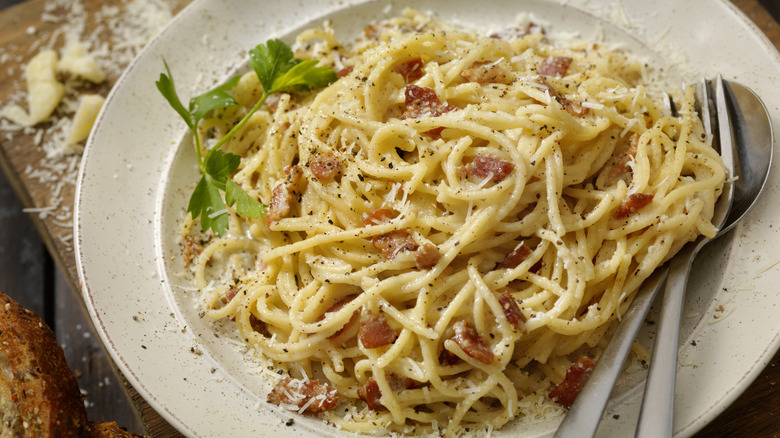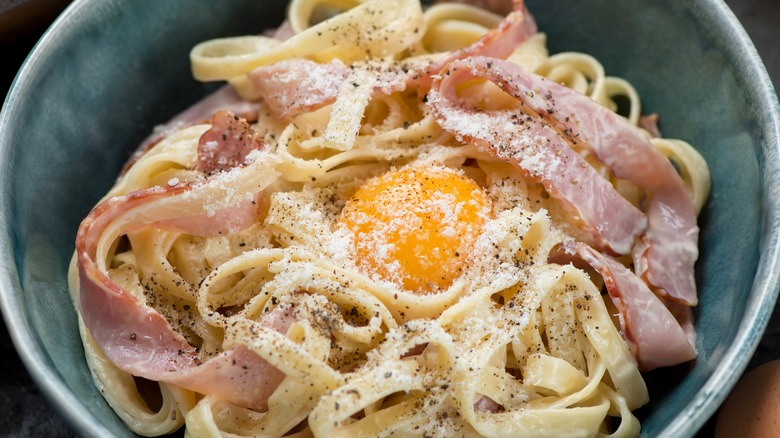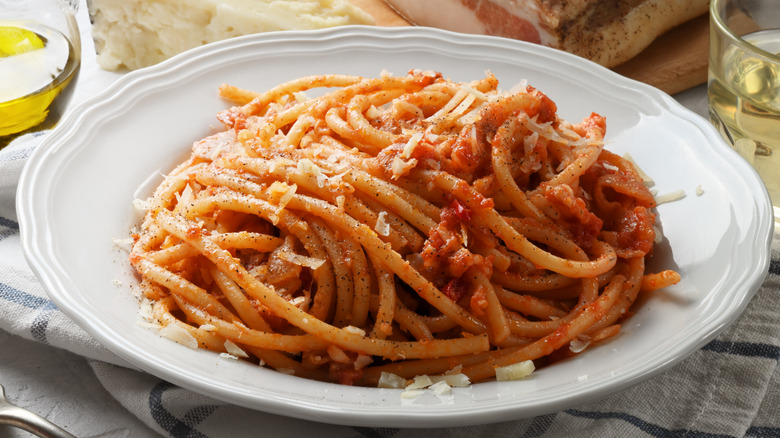The Key Ingredient Difference Between Amatriciana And Carbonara
In Rome, there are four iconic pasta dishes that, if you weren't looking closely, you'd swear are the same dish: pasta alla gricia, carbonara, amatriciana, and cacio e pepe. The through-line for these dishes is the combination of pasta and two or three of the following ingredients: black pepper, Pecorino Romano cheese, and guanciale, aka pork jowl. In order of least to most complex, the first is cacio e pepe, which is a sauce of cheese, pepper, and pasta water. The next is pasta alla gricia, which includes all the same ingredients (sometimes swapping the pasta water with white wine), but goes all in on the pork. And then we have carbonara and amatriciana.
While all these dishes certainly share a theme, because of their simplicity, an ingredient added or subtracted can make a world of difference. Carbonara and amatriciana begin exactly the same way: pasta is set to boil while some guanciale renders in a pan; however, it is the ingredients added after this point that make the difference between these two. For carbonara, you add eggs, which gives the pasta sauce a lovely creaminess. For amatriciana, you add tomatoes, the acidity of which is said to balance out the saltiness of the pork and cheese. Both are exceptionally flavorful in their own right while also being very simple to make.
Carbonara incorporates eggs
Where many other decadent pasta dishes get their richness from cream, carbonara gets it from a mix of egg, pasta water, and Pecorino. Because it's a component in the sauce, the eggs are not cooked in the pan along with the other protein, guanciale, as being exposed to the high heat would cause them to scramble. Some recipes call for using only egg yolks, but this can cause some consistency issues. Yolks alone tend to create a very thick and sticky sauce, the opposite of what you want for carbonara, therefore, it's better either to use whole eggs or a mixture of whole eggs and egg yolk for something a little richer.
When you're ready to start the sauce, mix the eggs together with the Pecorino and pepper and then set aside. Then, using some of the reserved starchy pasta water, the cooked pasta is transferred into the pan with the guanciale and stirred around so the pork fat coats the noodles. The pan is then removed from the heat, and the reserved pasta water is added in along with the egg mixture. As this is stirred, the heat from the pasta will gently cook the eggs, forming a very creamy and velvety sauce.
It certainly makes for a rich and delicious dish, though it hardly resembles (in flavor or texture) the tomato-centered amatriciana.
Amatriciana has a tomato sauce
Pasta amatriciana begins similar to pasta alla gricia and carbonara — with guanciale in a pan — though the pork has to share the stage with onions, which swim and caramelize in its melted fat. Amatriciana is a tomato-forward dish, so there should not be as much pork in this sauce as there is in the others. The juice from the tomatoes, along with some of that wonderfully starchy pasta water, are all that is needed to complete the sauce. Amatriciana can be made with a number of different pastas, but the hollow centered buccatini is the traditional favorite. As with the other pastas, the Pecorino and pepper are stirred in at the end to give it a rich finish.
The inclusion of tomatoes makes amatriciana the only one of the four that cuts the richness of the guanciale and cheese with acidity from the vegetables. Because of this complex balance of strong flavors, it's not a sauce you need to lay on thick like one might a marinara or ragu sauce. In terms of simplicity, amatriciana and carbonara are two of the simplest kinds of pasta out there, and you'd be hard-pressed to find ones more flavorful.


